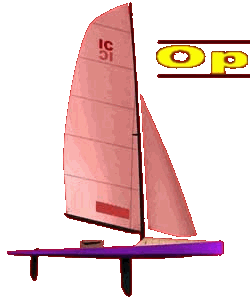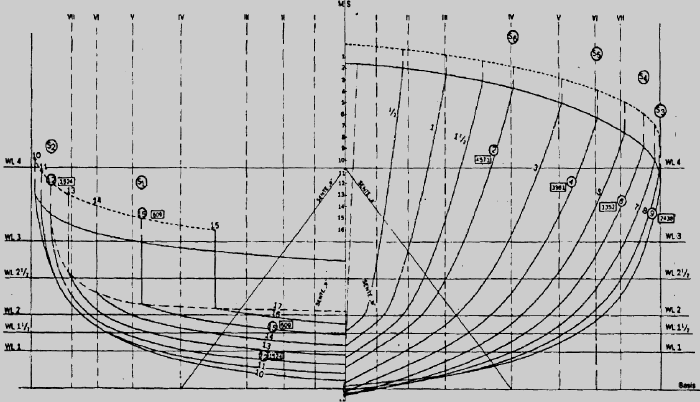

Unfortunately, getting a new IC is not easy. In the world there are only a few professional/semi-professional builders willing to build a complete IC (decked hull with seat, carriage, blades and cassettes). It is easier to order a shell and finish it off yourself or with the help of others in the class. The final option is to build the entire boat yourself. You can borrow a mold or start from scratch. | ||||||||||||||||||||||||||||||||||||
 Canada has possibly North America's only IC builder. Based out of Calgary, Martin Herbert (Virgin Forest Boatworks) builds all wood cold molded hulls. From all reports, Martin's work is excellent and he can build all the parts - seat, carriage etc. He can also deck glass shells. Price unknown probably ~ $8,000 - $10,000 ex sails, mast, fittings. Ted Van Dusen builds autoclave cured composite hulls, decks, carriages, masts, booms, daggerboards, rudders. Does he provide complete boats? - Not sure. Call him (508)371-3132 Razorback Boats - UK Rob Michaels. Impeccable carbon, klegecell hulls, mahogany decks, carbon reinforced. (1st and 2nd Aus Worlds '96). Builds all parts, complete or partial, also retrofit kit for assymetrics - 63 Brook Gardens, Emsworth, Hants, UK. Try Erich Chase in San Francisco. He finished off CAN 36 for Bob Lewis. Erich has both hull and deck molds. Address: 265 Grandview, Novato, California 94945 Brits John Ellis and Collin Brown have been building first class carbon boats. Placed first, fourth and sixth in '99 worlds. Describing the hull John writes, "The tolerances are mostly to the minus of the ICF lines i.e. the boat is narrower and the floor rises more quickly. The rocker line is average." Address: 55 Greenfield Drive, Eaglescliff, Stockton-on-Tees, TS 16 OHD  There are a smattering of molds around. It is possible to get a shell laid up by someone known and trusted by the owner of the mold. Below is a list of molds in North America and a contact person if known. Your best bet if you want a shell laid up is call or write to the appropriate contact and ask your questions there. Canadian Molds:
Sometime around 1985, Chris Maas on the west coast USA pulled a mold off of Del Olson's King Ferry boat and modified it slightly in the bow adding rocker and fullness. The mold was sold to the Calgary bunch - I'm not sure who actually owns it but you'd be safe contacting either Martin Herbert or Stu Bexton. Bill Beaver informs me that that Tom Squiccirrini in MI has negociated the purchase of it and is trying to get it shipped to MI. From old newsletter accounts, Maas I think also built an FRP deck mold. I assume it is in Calgary as well. This deck is unique in that it is convex for its whole length with its centerline a straight line from stem to stern. "Podmorski" I believe was the first canoe (NA? World?) to use the fore-aft sliding carriage. USA Molds:
This mold belongs to Bill Beaver, but is at Ted VanDusen's shop in Boston. Apparently there are aluminum deck molds - "sheets of aluminum beaten to shape". As far as Bill knows, this is the only autoclavable IC mold in existance. "NoGo55" is a seriously pushed tolerance design with less rocker, flatter sections, and deepest draft moved aft. The first four boats popped from this mold were baked carbon/pre-preg nomex cored hulls made from materials left over from "Cogito" - the successful challenger for the C-class cats "Little America's Cup". I don't know about the hulls since but I imagine they don't have to be built out of expensive exotics.
This is the mold that Greymater spawned from, as well as all the Kingferry boats and 4 shells produced for the SanFransisco Worlds. All US boats with sail numbers USA152-185 and USA199-203 came out of these molds Steve Clark has the hull mold, and a deck flange and V bulkhead mold. No deck mold exists. Most of the hulls were decked with plywood, although steve did lay up some flat composite decks (dropping out the core along the centerline to make a hinge) and pushed them in. Hull shape is "pretty close" to the drawn design, but flatter and straighter than the origional DKV plug. Contact: Steve Clark, Vanguard Sailboats, 200 Highpoint Ave., Portsmouth RI 02885
The "Cricket" or "Vanguard" molds were built by Erich Chase and Steve Clark in 1986-87 to try to build sensible glass ICs. There is an aft deck mold as well as a fordeck mold. The first two boats from this set were USA186 and 187 aka "After Midnight" and "Cricket." These molds went to California sometime around 1990 and were the basis of most of the newer California boats. This mold had it's topsides messed with to make the hull deck joint work and to try to make the boat better at the high and low end of the speed curve. ie it has slightly more rocker and more flare, particularly forward. Steve comments that this has helped these boats fast reaching, but has hurt them in chop and marginal planing. The hull and deck mold have an "inside out shoe box" hull/deck joint. Erich has seat and carriage molds as well.
David Bell and George Hughes made this mold in Vancouver, B.C. to produce two cold molded shells before lending it to the San Francisco bunch in 1983. Three or four more were made in SF. None have been made since and there is a good chance the mold doesn't exist anymore. Del Olsen (Dwolsen@aol.com) may be able to help. National Canoe Molds:
Ted has posession of Lou Whitman's "Pheonix" mold (from which my grandfathered hull was pulled back in the late sixties.) Ted layed up several "Pheonix" hulls but its been several years since any shells have been made from it. No deck mold exists for it. The "Pheonix" is a minimum surface area, maximum width design from the days when this was a development class. Bill Beaver described it once as the "aircraft carrier".
- Bill Beaver says that he's been told that a mold for a Procter Nethercott (may actually be an NC at this point) exists in Florida but knows very little about it.
The PG hull mold is a Nethercott hull but measures 6mm too flat two stations from stern. There is also a one piece deck mold. Call Bob Lewis (604)263-7244 (email: hsutherl@interchange.ubc.ca).  For many IC sailors this is the favoured means of obtaining a new hull. For others this is the only practical means of obtaining a new hull. Many in the class have an engineering/boatbuilding background. Many simply like "messin' about in boats" as a hobby. Still others want to control every aspect about the production of their IC. The International Canoe is restricted in it's hull shape. Below is a table of offset measurements that all ICs must abide by within +/- 10 mm. Sorry, no table yet.

| ||||||||||||||||||||||||||||||||||||